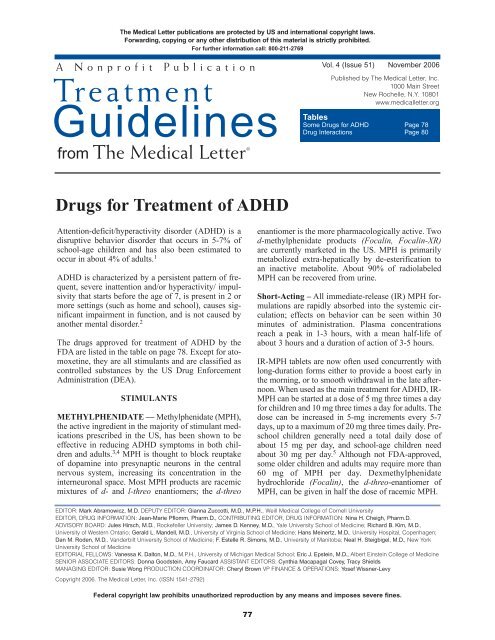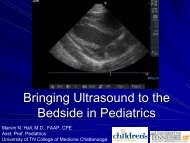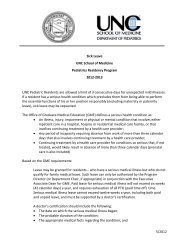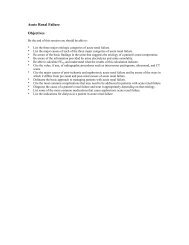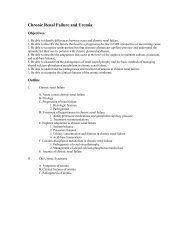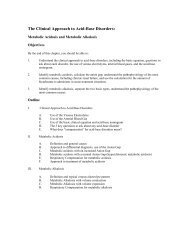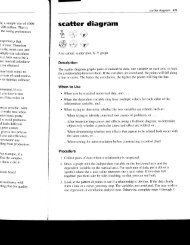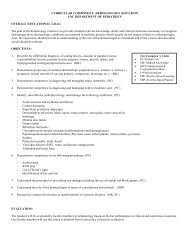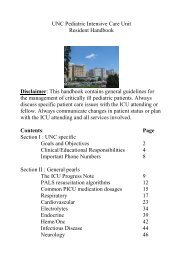2006 Nov (51): Treatment Guidelines - Drugs for Treatment of ADHD
2006 Nov (51): Treatment Guidelines - Drugs for Treatment of ADHD
2006 Nov (51): Treatment Guidelines - Drugs for Treatment of ADHD
You also want an ePaper? Increase the reach of your titles
YUMPU automatically turns print PDFs into web optimized ePapers that Google loves.
The Medical Letter publications are protected by US and international copyright laws.<br />
Forwarding, copying or any other distribution <strong>of</strong> this material is strictly prohibited.<br />
For further in<strong>for</strong>mation call: 800-211-2769<br />
A Nonpr<strong>of</strong>it Publication<br />
<strong>Treatment</strong><br />
<strong>Guidelines</strong><br />
®<br />
from The Medical Letter<br />
Vol. 4 (Issue <strong>51</strong>) <strong>Nov</strong>ember <strong>2006</strong><br />
Published by The Medical Letter, Inc.<br />
1000 Main Street<br />
New Rochelle, N.Y. 10801<br />
www.medicalletter.org<br />
Tables<br />
Some <strong>Drugs</strong> <strong>for</strong> <strong>ADHD</strong> Page 78<br />
Drug Interactions Page 80<br />
<strong>Drugs</strong> <strong>for</strong> <strong>Treatment</strong> <strong>of</strong> <strong>ADHD</strong><br />
Attention-deficit/hyperactivity disorder (<strong>ADHD</strong>) is a<br />
disruptive behavior disorder that occurs in 5-7% <strong>of</strong><br />
school-age children and has also been estimated to<br />
occur in about 4% <strong>of</strong> adults. 1<br />
<strong>ADHD</strong> is characterized by a persistent pattern <strong>of</strong> frequent,<br />
severe inattention and/or hyperactivity/ impulsivity<br />
that starts be<strong>for</strong>e the age <strong>of</strong> 7, is present in 2 or<br />
more settings (such as home and school), causes significant<br />
impairment in function, and is not caused by<br />
another mental disorder. 2<br />
The drugs approved <strong>for</strong> treatment <strong>of</strong> <strong>ADHD</strong> by the<br />
FDA are listed in the table on page 78. Except <strong>for</strong> atomoxetine,<br />
they are all stimulants and are classified as<br />
controlled substances by the US Drug En<strong>for</strong>cement<br />
Administration (DEA).<br />
STIMULANTS<br />
METHYLPHENIDATE — Methylphenidate (MPH),<br />
the active ingredient in the majority <strong>of</strong> stimulant medications<br />
prescribed in the US, has been shown to be<br />
effective in reducing <strong>ADHD</strong> symptoms in both children<br />
and adults. 3,4 MPH is thought to block reuptake<br />
<strong>of</strong> dopamine into presynaptic neurons in the central<br />
nervous system, increasing its concentration in the<br />
interneuronal space. Most MPH products are racemic<br />
mixtures <strong>of</strong> d- and l-threo enantiomers; the d-threo<br />
enantiomer is the more pharmacologically active. Two<br />
d-methylphenidate products (Focalin, Focalin-XR)<br />
are currently marketed in the US. MPH is primarily<br />
metabolized extra-hepatically by de-esterification to<br />
an inactive metabolite. About 90% <strong>of</strong> radiolabeled<br />
MPH can be recovered from urine.<br />
Short-Acting – All immediate-release (IR) MPH <strong>for</strong>mulations<br />
are rapidly absorbed into the systemic circulation;<br />
effects on behavior can be seen within 30<br />
minutes <strong>of</strong> administration. Plasma concentrations<br />
reach a peak in 1-3 hours, with a mean half-life <strong>of</strong><br />
about 3 hours and a duration <strong>of</strong> action <strong>of</strong> 3-5 hours.<br />
IR-MPH tablets are now <strong>of</strong>ten used concurrently with<br />
long-duration <strong>for</strong>ms either to provide a boost early in<br />
the morning, or to smooth withdrawal in the late afternoon.<br />
When used as the main treatment <strong>for</strong> <strong>ADHD</strong>, IR-<br />
MPH can be started at a dose <strong>of</strong> 5 mg three times a day<br />
<strong>for</strong> children and 10 mg three times a day <strong>for</strong> adults. The<br />
dose can be increased in 5-mg increments every 5-7<br />
days, up to a maximum <strong>of</strong> 20 mg three times daily. Preschool<br />
children generally need a total daily dose <strong>of</strong><br />
about 15 mg per day, and school-age children need<br />
about 30 mg per day. 5 Although not FDA-approved,<br />
some older children and adults may require more than<br />
60 mg <strong>of</strong> MPH per day. Dexmethylphenidate<br />
hydrochloride (Focalin), the d-threo-enantiomer <strong>of</strong><br />
MPH, can be given in half the dose <strong>of</strong> racemic MPH.<br />
EDITOR: Mark Abramowicz, M.D. DEPUTY EDITOR: Gianna Zuccotti, M.D., M.P.H., Weill Medical College <strong>of</strong> Cornell University<br />
EDITOR, DRUG INFORMATION: Jean-Marie Pflomm, Pharm.D., CONTRIBUTING EDITOR, DRUG INFORMATION: Nina H. Cheigh, Pharm.D.<br />
ADVISORY BOARD: Jules Hirsch, M.D., Rockefeller University; James D. Kenney, M.D., Yale University School <strong>of</strong> Medicine; Richard B. Kim, M.D.,<br />
University <strong>of</strong> Western Ontario; Gerald L. Mandell, M.D., University <strong>of</strong> Virginia School <strong>of</strong> Medicine; Hans Meinertz, M.D., University Hospital, Copenhagen;<br />
Dan M. Roden, M.D., Vanderbilt University School <strong>of</strong> Medicine; F. Estelle R. Simons, M.D., University <strong>of</strong> Manitoba; Neal H. Steigbigel, M.D., New York<br />
University School <strong>of</strong> Medicine<br />
EDITORIAL FELLOWS: Vanessa K. Dalton, M.D., M.P.H., University <strong>of</strong> Michigan Medical School; Eric J. Epstein, M.D., Albert Einstein College <strong>of</strong> Medicine<br />
SENIOR ASSOCIATE EDITORS: Donna Goodstein, Amy Faucard ASSISTANT EDITORS: Cynthia Macapagal Covey, Tracy Shields<br />
MANAGING EDITOR: Susie Wong PRODUCTION COORDINATOR: Cheryl Brown VP FINANCE & OPERATIONS: Yosef Wissner-Levy<br />
Copyright <strong>2006</strong>. The Medical Letter, Inc. (ISSN 1541-2792)<br />
Federal copyright law prohibits unauthorized reproduction by any means and imposes severe fines.<br />
77
Some <strong>Drugs</strong> <strong>for</strong> <strong>ADHD</strong><br />
Duration Pediatric Dosage Adult Dosage<br />
Drug Forms <strong>of</strong> Action Start/Typical Start/Typical Cost 1<br />
STIMULANTS 2<br />
Dexmethylphenidate<br />
Focalin (<strong>Nov</strong>artis) 2.5, 5, 10 mg tabs 5-6 h 2.5 mg AM/5 mg AM 5 mg AM/20 mg AM $25.20<br />
Focalin XR 3 5, 10, 15, 20 mg caps 12 h 5 mg AM/10 mg AM 5 mg AM/20 mg AM 102.00<br />
Methylphenidate<br />
short-acting 3-5 h 5 mg tid/10 mg tid 10 mg bid/20 mg tid<br />
generic 5, 10, 20 mg tabs 38.70<br />
Ritalin (<strong>Nov</strong>artis) 5, 10, 20 mg tabs 79.20<br />
Methylin (Mallinckrodt) 5, 10, 20 mg tabs 28.80<br />
Methylin Chewable Tablets 2.5, 5, 10 mg tabs 81.00<br />
(Alliant)<br />
Methylin Oral Solution 5 mg/5 mL, 94.50<br />
(Alliant) 10 mg/5 mL 4<br />
intermediate-acting<br />
3-8 h<br />
generic 20 mg tabs 5 20 mg AM/40 mg AM 20 mg AM/80 mg AM 54.60<br />
Ritalin SR (<strong>Nov</strong>artis) 20 mg tabs 5 112.80<br />
Metadate ER (Celltech) 10, 20 mg tabs 5 10 mg bid/30 mg AM 10 mg bid/80 mg AM 54.90<br />
Methylin ER (Mallinckrodt) 10, 20 mg tabs 5 49.80<br />
long-acting<br />
8-12 h<br />
Metadate CD (Celltech) 10, 20, 30, 40, 10 mg AM/30 mg AM 20 mg AM/80 mg AM 76.80<br />
50, 60 mg tabs<br />
Ritalin LA 3 (<strong>Nov</strong>artis) 10, 20, 30, 40 mg 10 mg AM/30 mg AM 10 mg AM/80 mg AM 89.70<br />
caps<br />
Concerta (Alza) 18, 27, 36, 54 mg 10-12 h 18 mg AM/36 mg AM 18 mg AM/72 mg AM 111.90<br />
tabs 5<br />
Daytrana (<strong>Nov</strong>en/Shire) 12.5, 18.75, 25, 10-12 h 10 mg patch on 9hrs, 10 mg patch on 9hrs 141.60<br />
37.5 cm 2 <strong>of</strong>f 15hrs/ <strong>of</strong>f 15hrs/<br />
transdermal patch 6 30 mg patch on 9hrs, 60 mg patch on 9hrs,<br />
<strong>of</strong>f 15hrs<br />
<strong>of</strong>f 15hrs<br />
Dextroamphetamine<br />
short-acting 4-6 h 5 mg bid/10 mg bid 5 mg bid/15 mg bid<br />
generic 3 5, 10 mg tabs 32.40<br />
Dextrostat 3 (Shire) 5, 10 mg tabs 27.60<br />
Dexedrine 3 (GSK) 5 mg tabs 67.20<br />
long-acting 6-8 h 5 mg AM/15 mg AM 5 mg AM/30 mg AM<br />
generic 3 5, 10, 15 mg caps 33.30<br />
Dexedrine Spansules 3 (GSK) 5, 10, 15 mg caps 62.70<br />
Amphetamine Mixed Salts<br />
short-acting 4-6 h 5 mg bid/10 mg bid 5 mg bid/15 mg bid<br />
generic 3 5, 7.5, 10, 12.5, 66.60<br />
15, 20, 30 mg tabs<br />
Adderall 3 (Shire) 5, 7.5, 10, 12.5, 5 mg bid/10 mg bid 5 mg bid/10 mg bid 138.00<br />
15, 20, 30 mg tabs<br />
long-acting<br />
8-10 h<br />
Adderall XR 3 (Shire) 5, 10, 15, 20, 25, 5 mg AM/30 mg AM 5 mg AM/60 mg AM 113.10<br />
30 mg caps<br />
NON-STIMULANTS<br />
Atomoxetine<br />
Strattera (Lilly) 10, 18, 25, 40, 24 h 0.5 mg/kg/d once or 40 mg once/ 129.00 7<br />
60, 80, 100 mg caps divided bid/ 80 mg once or<br />
1.2 mg/kg/d once or divided bid<br />
divided bid<br />
1. Cost <strong>for</strong> 30 days' treatment with the typical pediatric dosage, based on most recent data (August 30, <strong>2006</strong>) from retail pharmacies nationwide available from<br />
Wolters Kluwer Health.<br />
2. All are classified by the DEA as Schedule II controlled substances.<br />
3. Should not be taken with antacids or other drugs that decrease gastric acidity.<br />
4. Available in bottles containing 500 mL.<br />
5. Must be swallowed whole, not crushed or chewed.<br />
6. The four patch sizes deliver 10, 15, 20, 30 mg over 9 hours, respectively. Daytrana is supplied in sealed trays containing 10 or 30 patches in individual pouches.<br />
7. Cost <strong>of</strong> 30 60-mg capsules.<br />
<strong>Treatment</strong> <strong>Guidelines</strong> from The Medical Letter • Vol. 4 (Issue <strong>51</strong>) • <strong>Nov</strong>ember <strong>2006</strong><br />
78
<strong>Drugs</strong> <strong>for</strong> <strong>Treatment</strong> <strong>of</strong> <strong>ADHD</strong><br />
Methylin is a short-acting MPH branded generic that<br />
has been <strong>for</strong>mulated in chewable tablets and an oral<br />
solution <strong>for</strong> young children who have difficulty swallowing<br />
tablets or capsules. Peak plasma concentrations<br />
<strong>of</strong> MPH are achieved within 1-2 hours with the<br />
chewable tablets; high-fat meals delay the peak by 1<br />
hour. No large-scale clinical trials using these <strong>for</strong>mulations<br />
have been published.<br />
Long-Acting – Despite the effectiveness <strong>of</strong> IR-MPH,<br />
its 3-5 hour duration <strong>of</strong> action usually requires mid-day<br />
dosing in school, which children may find disruptive or<br />
stigmatizing. The short duration <strong>of</strong> action also requires<br />
administration by non-family adults when children<br />
participate in after-school programs. Long-duration<br />
MPH preparations with once-daily dosing have there<strong>for</strong>e<br />
become the mainstay <strong>of</strong> clinical practice.<br />
Single-Pulse (Ritalin-SR, Metadate ER, Methylin<br />
ER) – Single-pulse, sustained-release MPH <strong>for</strong>mulations<br />
use a wax matrix to prolong release. They have a<br />
slower onset <strong>of</strong> action than IR-MPH and a duration <strong>of</strong><br />
action <strong>of</strong> up to 8 hours, but some clinicians have found<br />
their duration <strong>of</strong> action to be highly variable and view<br />
these drugs as less effective in practice than immediate-release,<br />
beaded double-pulse, or osmotic-release<br />
MPH (OROS-MPH) preparations. Many clinicians<br />
prescribe single-pulse <strong>for</strong>mulations twice daily, and<br />
some add an immediate-release tablet in the morning.<br />
Beaded Double-Pulse (Ritalin LA, Focalin XR,<br />
Metadate CD) – Beaded MPH products use an extended-release<br />
<strong>for</strong>mulation with a bi-modal release mechanism.<br />
With Ritalin LA and Focalin XR, half the dose<br />
is in immediate-release beads and half in enteric-coated,<br />
delayed-release beads. Metadate CD contains 30%<br />
immediate-release beads and 70% delayed-release<br />
beads. In young children who have difficulty swallowing<br />
pills, the capsules can be opened and the beads<br />
sprinkled into a small amount <strong>of</strong> cold applesauce or<br />
vanilla ice cream to disguise the bitter taste.<br />
Osmotic-Release (Concerta; OROS-MPH) – The<br />
Concerta tablet uses an osmotic delivery system to<br />
extend the duration <strong>of</strong> action <strong>of</strong> MPH to up to 12<br />
hours. 6,7 The tablet is coated with IR-MPH <strong>for</strong> immediate<br />
action. The rest <strong>of</strong> the dose is delivered by an osmotic<br />
pump that gradually releases the drug over a 10-hour<br />
period, producing slightly ascending MPH serum concentrations.<br />
Taken once daily, serum concentrations are<br />
similar to those produced by taking IR-MPH three times<br />
daily, but with less variation. 8 The tablets themselves are<br />
excreted intact in the stool.<br />
Three double-blind, randomized clinical trials have<br />
compared OROS-MPH to IR-MPH in children with<br />
<strong>ADHD</strong>; the results show that the reductions in <strong>ADHD</strong><br />
symptoms that occur with once-daily doses <strong>of</strong> OROS-<br />
MPH match those achieved with multiple doses <strong>of</strong> IR-<br />
MPH. 9,10,11 Studies in adolescents have also demonstrated<br />
effectiveness with OROS-MPH. 12 In one small<br />
study in 6 patients, OROS-MPH taken once daily in<br />
the morning was more effective in reducing <strong>ADHD</strong>induced<br />
driving impairments in the evening than IR-<br />
MPH taken three times daily. 13<br />
Transdermal (Daytrana) – Transdermal MPH appears<br />
to be as effective as other long-duration MPH preparations,<br />
but adverse effects such as anorexia, insomnia,<br />
and tics have occurred more frequently with the patch<br />
<strong>for</strong>mulation. Mild skin reactions are common. 14 After<br />
application <strong>of</strong> the transdermal patch, MPH is steadily<br />
absorbed and reaches peak concentrations in serum<br />
after 7-9 hours. Chronic dosing with the patch results in<br />
higher peak MPH levels than with equivalent doses <strong>of</strong><br />
OROS-MPH. The duration <strong>of</strong> MPH action <strong>for</strong> a 9-hour<br />
wear period is about 11.5 hours. A double-blind, placebo-controlled<br />
crossover study conducted in a laboratory<br />
classroom showed significantly lower <strong>ADHD</strong> symptom<br />
scores and higher math test scores with the MPH<br />
patch compared to a placebo patch during postdose<br />
hours 2 through 12. 15 One advantage <strong>of</strong> the patch <strong>for</strong>mulation<br />
is that it can be removed early in patients who<br />
have a problem with insomnia.<br />
AMPHETAMINES — Like MPH, amphetamines<br />
used to treat <strong>ADHD</strong> are available as either the d-isomer,<br />
dextroamphetamine (Dexedrine, Dextrostat), or<br />
in racemic <strong>for</strong>ms, which are mixtures <strong>of</strong> d- and l-<br />
amphetamine (Adderall, Adderall XR).<br />
Dextroamphetamine – Dextroamphetamine has been as<br />
effective as MPH in decreasing overactivity, impulsivity<br />
and inattention in children with <strong>ADHD</strong>. Some children<br />
unresponsive to MPH may respond to dextroamphetamine,<br />
and vice versa. Absorption <strong>of</strong> dextroamphetamine<br />
is rapid; plasma concentrations reach a peak 3 hours after<br />
oral administration. Taking the drug with ascorbic acid or<br />
fruit juice tends to decrease absorption <strong>of</strong> amphetamine,<br />
while alkalinizing agents such as sodium bicarbonate<br />
tend to increase absorption. Acidification <strong>of</strong> the urine<br />
increases amphetamine excretion.<br />
The onset <strong>of</strong> action <strong>of</strong> dextroamphetamine occurs<br />
within one hour <strong>of</strong> ingestion, and its duration <strong>of</strong> action<br />
is up to 5 hours, somewhat longer than that <strong>of</strong> MPH.<br />
Twice-daily administration is needed to extend the<br />
treatment throughout the school day, and children may<br />
dislike taking the second dose in school.<br />
Mixtures – Adderall and Adderall XR are mixtures <strong>of</strong><br />
amphetamine salts. Adderall XR is a double-pulse cap-<br />
<strong>Treatment</strong> <strong>Guidelines</strong> from The Medical Letter • Vol. 4 (Issue <strong>51</strong>) • <strong>Nov</strong>ember <strong>2006</strong><br />
79
<strong>Drugs</strong> <strong>for</strong> <strong>Treatment</strong> <strong>of</strong> <strong>ADHD</strong><br />
sule <strong>for</strong>mulation that contains both immediate-release<br />
and extended-release beads. There is no evidence that<br />
these mixed amphetamine salts <strong>of</strong>fer any advantage<br />
over MPH or dextroamphetamine, but some patients<br />
respond to one and not to another.<br />
Some older children say that stimulants make them<br />
feel less spontaneous and less com<strong>for</strong>table in their<br />
social interactions. Drug holidays during weekends<br />
and vacations may be helpful, particularly in making<br />
up <strong>for</strong> weight loss and slow growth.<br />
ADVERSE EFFECTS — Adverse events frequently<br />
reported during use <strong>of</strong> any stimulant include delayed<br />
sleep onset, headache, decreased appetite and weight<br />
loss. Infrequent adverse events include emotional<br />
lability and either new onset or an increase in the frequency<br />
<strong>of</strong> tics. Tactile and visual hallucinations can<br />
occur. Stimulants can slow growth and possibly lower<br />
the convulsive threshold. They should be used with<br />
great care in patients with a history <strong>of</strong> mania, psychosis,<br />
drug dependence or alcoholism.<br />
The most common adverse events leading to discontinuation<br />
<strong>of</strong> treatment with stimulants have been motor or<br />
vocal tics, anorexia, insomnia and tachycardia.<br />
Some Drug Interactions*<br />
Reports <strong>of</strong> 20 cases <strong>of</strong> sudden unexpected death (14<br />
children and 6 adults) and 12 cases <strong>of</strong> stroke in patients<br />
taking Adderall XR led Health Canada to suspend sales<br />
<strong>of</strong> the drug. 16 That decision was later reversed. The<br />
FDA decided that the number <strong>of</strong> sudden deaths was no<br />
greater than expected among the large number <strong>of</strong> people<br />
taking the drug, but because 5 <strong>of</strong> the children who<br />
died had structural heart defects, a warning against<br />
using any stimulant in such patients was added.<br />
Routine ECGs and echocardiograms are not indicated<br />
be<strong>for</strong>e starting stimulants in a patient who has an unremarkable<br />
history and physical examination. Patients<br />
with pre-existing heart disease should be referred to a<br />
Comments and<br />
Interacting <strong>Drugs</strong> Effects Probable Mechanism Recommendations<br />
METHYLPHENIDATE:<br />
Carbamazepine Possible decreased Possibly increased metabolism May require methylphenidate dose<br />
(Tegretol) methylphenidate effect increase<br />
Clonidine (Catapres) ECG abnormalities and sudden Mechanism unknown; cause and effect Monitor blood pressure and pulse<br />
death<br />
not established<br />
MAO inhibitors and Hypertensive crisis Increased release <strong>of</strong> norepinephrine Should not be used concurrently or<br />
linezolid (Zyvox)<br />
within 2 weeks <strong>of</strong> each other<br />
Phenobarbital Possible phenobarbital toxicity Decreased metabolism Monitor phenobarbital concentrations<br />
Phenytoin (Dilantin) Possible phenytoin toxicity Decreased metabolism Monitor phenytoin concentrations<br />
Sympathomimetics Increased blood pressure and Additive Monitor clinical status<br />
heart rate<br />
Tricyclic antidepress- Possible increase in TCA serum Inhibition <strong>of</strong> TCA metabolism Monitor clinical status and TCA serum<br />
ants (TCAs) concentrations concentrations; reported with<br />
imipramine and desipramine<br />
Warfarin (Coumadin) Increased anticoagulant effect Decreased metabolism Monitor INR<br />
AMPHETAMINES:<br />
Acetazolamide Increased amphetamine effect Urinary alkalinization decreases Monitor clinical status; could occur<br />
(Diamox) amphetamine excretion with other drugs that increase<br />
urine PH<br />
Antacids Increased amphetamine effect Urinary alkalinization decreases Monitor clinical status; reported with<br />
amphetamine excretion<br />
sodium bicarbonate<br />
MAO inhibitors and Increased amphetamine effect; Decreased amphetamine metabolism Should not be used concurrently<br />
linezolid (Zyvox) hypertensive crisis or within 2 weeks <strong>of</strong> each other<br />
Sympathomimetics Increased blood pressure and Additive Monitor clinical status<br />
heart rate<br />
Tricyclic antidepress- Increased cardiovascular effects Additive Monitor clinical status<br />
ants (TCAs)<br />
ATOMOXETINE:<br />
Albuterol Increased blood pressure and Additive Reported with IV albuterol; could<br />
heart rate<br />
occur with other systemically<br />
administered B 2 agonists<br />
Fluoxetine (Prozac) Increased atomoxetine effect Decreased atomoxetine metabolism; Atomoxetine dose reduction or slow<br />
inhibition <strong>of</strong> CYP2D6<br />
titration may be needed<br />
MAO inhibitors and Severe atomoxetine toxicity, Increased brain monoamine Should not be used concurrently or<br />
linezolid (Zyvox) possibly fatal concentrations within 2 weeks <strong>of</strong> each other<br />
Paroxetine (Paxil) Increased atomoxetine effect Decreased atomoxetine metabolism; Atomoxetine dose reduction or slow<br />
inhibition <strong>of</strong> CYP2D6<br />
titration may be needed<br />
Quinidine Increased atomoxetine effect Decreased atomoxetine metabolism; Atomoxetine dose reduction or slow<br />
inhibition <strong>of</strong> CYP2D6<br />
titration may be needed<br />
*See The Medical Letter’s Adverse Drug Interactions Program <strong>for</strong> references and additional interactions.<br />
<strong>Treatment</strong> <strong>Guidelines</strong> from The Medical Letter • Vol. 4 (Issue <strong>51</strong>) • <strong>Nov</strong>ember <strong>2006</strong><br />
80
<strong>Drugs</strong> <strong>for</strong> <strong>Treatment</strong> <strong>of</strong> <strong>ADHD</strong><br />
cardiologist be<strong>for</strong>e starting stimulant treatment. Known<br />
cardiac problems that require special caution in using<br />
stimulants include postoperative tetralogy <strong>of</strong> Fallot,<br />
coronary artery abnormalities and obstructive subaortic<br />
stenosis. Hypertension, syncope (especially during exercise),<br />
arrhythmias or chest pain may be signs <strong>of</strong> hypertrophic<br />
cardiomyopathy, which has been associated with<br />
sudden unexpected death in patients taking stimulants.<br />
Contraindications – Clinical conditions that can be<br />
exacerbated by stimulant treatment include psychosis,<br />
mania, Tourette syndrome and closed-angle glaucoma.<br />
NON-STIMULANTS<br />
ATOMOXETINE – A selective norepinephrine reuptake<br />
inhibitor, atomoxetine (Strattera) was the first<br />
drug to be approved by the FDA to treat <strong>ADHD</strong> in both<br />
children and adults. 17 It is neither a controlled substance<br />
nor a stimulant.<br />
Pharmacokinetics – Atomoxetine is rapidly absorbed,<br />
with peak serum concentrations occurring within 1<br />
hour without food and in
<strong>Drugs</strong> <strong>for</strong> <strong>Treatment</strong> <strong>of</strong> <strong>ADHD</strong><br />
once a day in children with attention-deficit/hyperactivity disorder.<br />
Pediatrics 2001; 108:883.<br />
10. J Swanson et al. Development <strong>of</strong> a new once-a-day <strong>for</strong>mulation <strong>of</strong><br />
methylphenidate <strong>for</strong> the treatment <strong>of</strong> attention-deficit/hyperactivity<br />
disorder: pro<strong>of</strong>-<strong>of</strong>-concept and pro<strong>of</strong>-<strong>of</strong>-product studies. Arch Gen<br />
Psychiatry 2003; 60:204.<br />
11. WE Pelham et al. Once-a-day Concerta methylphenidate versus threetimes-daily<br />
methylphenidate in laboratory and natural settings.<br />
Pediatrics 2001; 107:E105.<br />
12. TE Wilens et al. Multisite controlled study <strong>of</strong> OROS methylphenidate<br />
in the treatment <strong>of</strong> adolescents with attention-deficit/hyperactivity<br />
disorder. Arch Pediatr Adolesc Med <strong>2006</strong>; 160:82.<br />
13. DJ Cox et al. Impact <strong>of</strong> methylphenidate delivery pr<strong>of</strong>iles on driving<br />
per<strong>for</strong>mance <strong>of</strong> adolescents with attention-deficit/hyperactivity disorder:<br />
a pilot study. J Am Acad Child Adolesc Psychiatry 2004; 43:269.<br />
14. Transdermal methylphenidate (Daytrana) <strong>for</strong> <strong>ADHD</strong>. Med Lett <strong>Drugs</strong><br />
Ther <strong>2006</strong> 48:49.<br />
15. JJ McGough et al. A randomized, double-blind, placebo-controlled,<br />
laboratory classroom assessment <strong>of</strong> methylphenidate transdermal system<br />
in children with <strong>ADHD</strong>. J Atten Disord <strong>2006</strong>; 9:476.<br />
16. Adderall. Med Lett <strong>Drugs</strong> Ther 2005; 47:28.<br />
17. Atomoxetine (Strattera) <strong>for</strong> <strong>ADHD</strong>. Med Lett <strong>Drugs</strong> Ther 2003; 45:11.<br />
18. SB Wigal et al. A laboratory school comparison <strong>of</strong> mixed amphetamine<br />
salts extended release (Adderall XR) and atomoxetine (Strattera) in<br />
school-aged children with attention deficit/hyperactivity disorder. J<br />
Atten Disord 2005; 9:275.<br />
19. Drug interactions. Med Lett <strong>Drugs</strong> Ther 2003; 45:46.<br />
20. New indications <strong>for</strong> modafinil (Provigil). Med Lett <strong>Drugs</strong> Ther 2004;<br />
46:34.<br />
21. JS Ballon and D Feifel. A systematic review <strong>of</strong> modafinil: potential<br />
clinical uses and mechanisms <strong>of</strong> action. J Clin Psychiatry <strong>2006</strong>; 67:554.<br />
22. SR Pliszka et al. Comparative effects <strong>of</strong> methylphenidate and mixed<br />
salts amphetamine on height and weight in children with attentiondeficit/hyperactivity<br />
disorder. J Am Acad Child Adolesc Psychiatry<br />
<strong>2006</strong>; 45:520.<br />
Coming Soon in <strong>Treatment</strong> <strong>Guidelines</strong>:<br />
Surgical Prophylaxis – December <strong>2006</strong><br />
Eye Disorders – January 2007<br />
Coming Soon in The Medical Letter:<br />
Posaconazole (Noxafil) <strong>for</strong> Fungal Infections<br />
Rasagiline (Azilect) <strong>for</strong> Parkinson’s Disease<br />
Transdermal Fentanyl (Ionsys) <strong>for</strong> Pain<br />
Also available from<br />
THE MEDICAL LETTER:<br />
The Medical Letter on <strong>Drugs</strong> and Therapeutics<br />
newsletter is an independent, nonpr<strong>of</strong>it publication<br />
that <strong>of</strong>fers unbiased, critical evaluations <strong>of</strong> drugs to<br />
healthcare pr<strong>of</strong>essionals worldwide. Bi-weekly, 26<br />
issues per year. Subscription includes print, fulltext<br />
online access and s<strong>of</strong>tware <strong>for</strong> PDAs.<br />
GROUP SITE LICENSE<br />
Available in a searchable <strong>for</strong>mat and either by IP<br />
authentication or secure password login. For a onemonth<br />
free trial go to: http://medicalletter.org/html/<br />
institutions.htm or contact Gene Carbona at:<br />
800-211-2769 x315 or gene@medicalletter.org<br />
CME PROGRAM<br />
• Accepted by the ACCME, AAFP & ACPE<br />
• Available as a semi-annual exam in print or<br />
online, or as a per issue test with answers<br />
submitted online only.<br />
HANDBOOKS<br />
• Handbook <strong>of</strong> Antimicrobial Therapy<br />
• <strong>Drugs</strong> <strong>of</strong> Choice<br />
SOFTWARE<br />
• The Medical Letter 1988-June <strong>2006</strong>:<br />
A Searchable Collection on CD<br />
• The Adverse Drug Interactions Program<br />
on CD and <strong>for</strong> Palm OS<br />
REFERENCE BOOKS<br />
• 2005 Bound Volume Edition <strong>of</strong> <strong>Treatment</strong><br />
<strong>Guidelines</strong> from The Medical Letter<br />
• 2005 Bound Volume Edition <strong>of</strong> The Medical Letter<br />
To subscribe, call (800) 211-2769 or visit online<br />
www.medicalletter.org<br />
Subscription Services<br />
Mailing Address<br />
The Medical Letter, Inc.<br />
1000 Main Street<br />
New Rochelle, NY 10801-7537<br />
Customer Service<br />
Call: 800-211-2769 or 914-235-0500<br />
M-F 8am-6pm Eastern Time<br />
Fax: 914-632-1733<br />
Email: custserv@medicalletter.org<br />
Web Site<br />
www.medicalletter.org<br />
Back Issues<br />
Back issues are $12 each.<br />
Subscriptions<br />
1 year - $98; 2 years - $167;<br />
3 years - $235. $49.00 per year<br />
<strong>for</strong> students, interns, residents and<br />
fellows in the US and Canada.<br />
All prices include print, full-text online<br />
access and handheld s<strong>of</strong>tware.<br />
Major credit cards accepted.<br />
Bulk Subscriptions<br />
Special reduced rates <strong>for</strong> bulk<br />
subscriptions. Contact Customer<br />
Service at 800-211-2769. Special<br />
Classroom rates are available.<br />
Site license inquires to:<br />
info@medicalletter.org or call 800-211-2769 x315<br />
Permissions<br />
To reprint any portion <strong>of</strong> this issue, e-mail<br />
your request to: permissions@medicalletter.org.<br />
Copyright and Disclaimer<br />
No part <strong>of</strong> the material may be reproduced or<br />
transmitted by any process in whole or in part<br />
without prior permission in writing. The editors<br />
do not warrant that all the material in this publication<br />
is accurate and complete in every<br />
respect. The editors shall not be held responsible<br />
<strong>for</strong> any damage resulting from any error,<br />
inaccuracy or omission.<br />
The Medical Letter is an independent<br />
nonpr<strong>of</strong>it organization that provides<br />
health care pr<strong>of</strong>essionals with unbiased<br />
drug prescribing recommendations. The<br />
editorial process used <strong>for</strong> its publications<br />
relies on a review <strong>of</strong> published and<br />
unpublished literature, with an emphasis<br />
on controlled clinical trials, and on the<br />
opinions <strong>of</strong> its consultants. The Medical<br />
Letter is supported solely by subscription<br />
fees and accepts no advertising, grants or<br />
donations. The editors declare no conflict<br />
<strong>of</strong> interest. The members <strong>of</strong> the Advisory<br />
Board are required to disclose any potential<br />
conflict <strong>of</strong> interest.<br />
<strong>Treatment</strong> <strong>Guidelines</strong> from The Medical Letter • Vol. 4 (Issue <strong>51</strong>) • <strong>Nov</strong>ember <strong>2006</strong><br />
82


